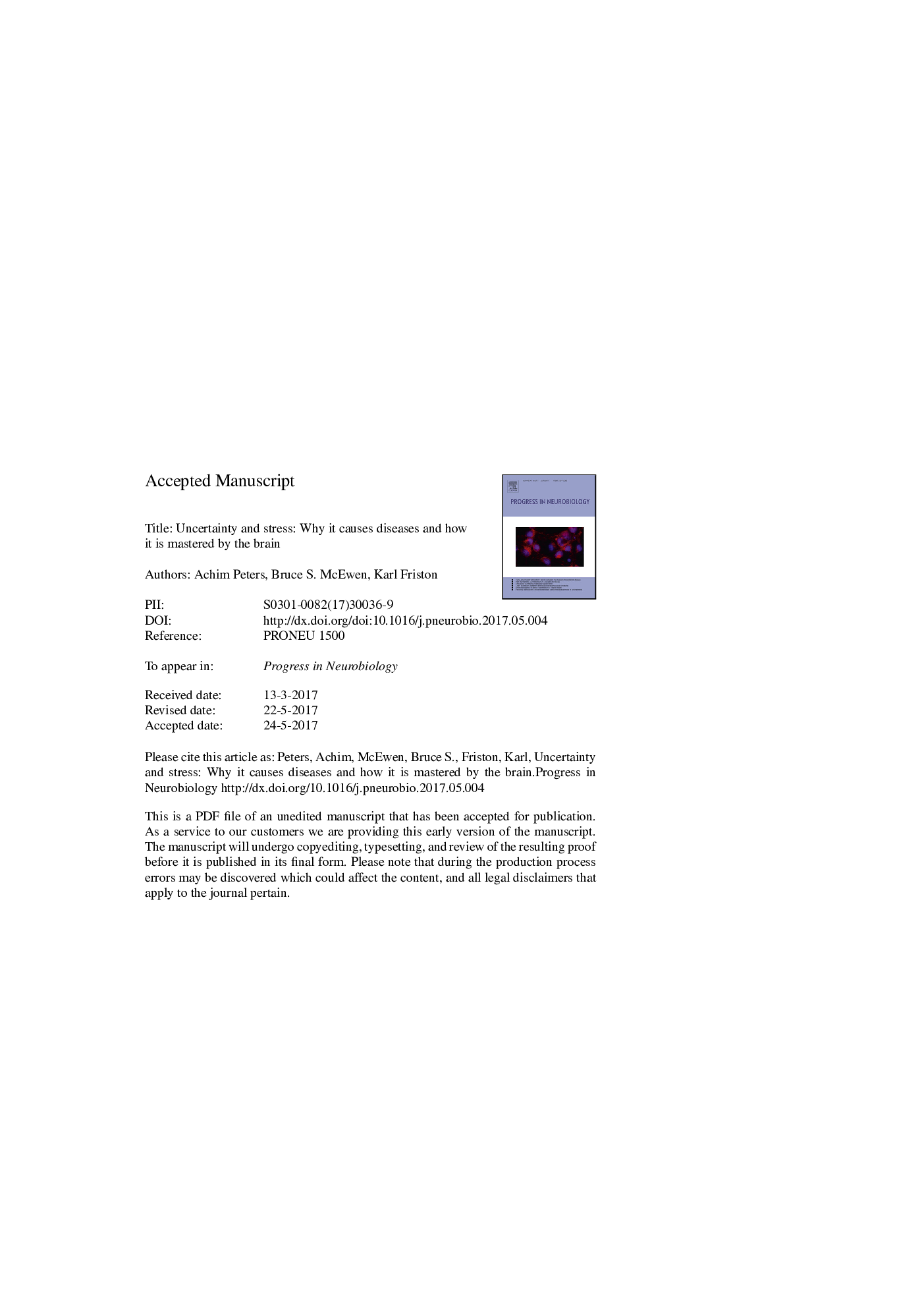| کد مقاله | کد نشریه | سال انتشار | مقاله انگلیسی | نسخه تمام متن |
|---|---|---|---|---|
| 5739104 | 1615359 | 2017 | 93 صفحه PDF | دانلود رایگان |
عنوان انگلیسی مقاله ISI
Uncertainty and stress: Why it causes diseases and how it is mastered by the brain
ترجمه فارسی عنوان
عدم اطمینان و استرس: چرا باعث بیماری می شود و چگونه مغز آن را تسلط می دهد
دانلود مقاله + سفارش ترجمه
دانلود مقاله ISI انگلیسی
رایگان برای ایرانیان
کلمات کلیدی
TrkBStress habituationHypothalamus pituitary adrenal axisSNSGLUT4layer 1GLUT1vmPFCOFCACCPFCAtherosclerosis - آترواسکلروز(تصلب شریان)γ-aminobutyric acid - اسید γ-آمینوبوتیریکlong-term depression - افسردگی طولانی مدتAllostatic load - بار Allostatictropomyosin receptor kinase B - تریپومیوسین گیرنده کیناز Blong-term potentiation - تقویت درازمدتLTP - تقویت طولانی مدت یا LTP Attention - توجهglucose transporter 4 - حمل کننده گلوکز 4sympathetic nervous system - سیستم عصبی سمپاتیکUncertainty - عدم قطعیتprefrontal cortex - قشر prefrontalorbitofrontal cortex - قشر اوربیتوفرنتالanterior cingulate cortex - قشر سینگولیت قدامی، کورتکس سینگولیت قدامیlocus coeruleus - لوکوس سیرولئوسbrain energy metabolism - متابولیسم انرژی مغزLTD - محدودMortality - مرگ ومیرBayesian brain - مغز بیزیPre-supplementary motor area - منطقه موتور قبل از تکمیلHPA - میلی بار یا هکتوپاسکالnorepinephrine - نوراپی نفرینPre-SMA - پیش SMAventromedial prefrontal cortex - کورتکس prefrontal ventromedialGABA - گاباglucose transporter 1 - گلوکز 1Mineralocorticoid receptors - گیرنده های Mineralocorticoidglucocorticoid receptors - گیرنده های گلوکوکورتیکوئیدLearning - یادگیری
ترجمه چکیده
اصطلاح "استرس" - که در سال 1936 ساخته شده - دارای تعاریف فراوانی است اما تا کنون فاقد مبانی نظری بوده است. در اینجا، رویکردی بر مبنای "اصل انرژی آزاد" - تعریف ماهیت استرس - روش نظری اطلاعاتی ارائه می کنیم. یعنی عدم اطمینان ما سه سوال را مطرح می کنیم: عدم اطمینان چیست؟ به ما چه می کند؟ منابع ما برای مدیریت آن چه هستند؟ صحبت از نظر ریاضی، عدم اطمینان آنتروپی یا «انتظار تعجب» است. اصل "انرژی آزاد" بر این واقعیت استوار است که عوامل بیولوژیک خودسازمانده در برابر تمایل به اختلال مقاومت می کنند و بنابراین باید آنتیبادی از حالت های حسی خود را به حداقل برسانند. این امر به زندگی روزمره ما بستگی دارد، به این معنی است که ما احساس ناامنی می کنیم، وقتی پیش بینی می کنیم که نتایج به چیزی غیر از انتظار منتهی شود، و ما قادر به اجتناب از تعجب نیستیم. همانطور که همه سیستم های شناختی تلاش می کنند عدم اطمینان خود را در مورد نتایج آینده کاهش دهند، آنها با محدودیت های حیاتی مواجه می شوند: کاهش عدم قطعیت نیاز به انرژی مغزی دارد. مشخصه مغز مهره دار برای اولویت بندی انرژی بالا خود را با مفهوم "مغز خودخواه" گرفته شده است. بر این اساس، در زمان عدم قطعیت، مغز خودخواه انرژی بیشتری از بدن درخواست می کند. اگر با وجود این همه، مغز نمی تواند عدم قطعیت را کاهش دهد، ممکن است یک بحران انرژی مداوم مغزی ایجاد شود، فرد بارور با بار بارگزاری "آلوزاتیک"، که به نقص عملکرد سیستمیک و مغزی (حافظه، بیماری های آتروژنیک، دیابت و حوادث قلب و عروق) . بر اساس اصل اساسی که استرس ناشی از عدم قطعیت است، ما بحث می کنیم که استراتژی های مغز ما برای جلوگیری از تعجب استفاده می شود و بنابراین عدم اطمینان را حل می کند.
موضوعات مرتبط
علوم زیستی و بیوفناوری
علم عصب شناسی
علوم اعصاب (عمومی)
چکیده انگلیسی
The term 'stress' - coined in 1936 - has many definitions, but until now has lacked a theoretical foundation. Here we present an information-theoretic approach - based on the 'free energy principle' - defining the essence of stress; namely, uncertainty. We address three questions: What is uncertainty? What does it do to us? What are our resources to master it? Mathematically speaking, uncertainty is entropy or 'expected surprise'. The 'free energy principle' rests upon the fact that self-organizing biological agents resist a tendency to disorder and must therefore minimize the entropy of their sensory states. Applied to our everyday life, this means that we feel uncertain, when we anticipate that outcomes will turn out to be something other than expected - and that we are unable to avoid surprise. As all cognitive systems strive to reduce their uncertainty about future outcomes, they face a critical constraint: Reducing uncertainty requires cerebral energy. The characteristic of the vertebrate brain to prioritize its own high energy is captured by the notion of the 'selfish brain'. Accordingly, in times of uncertainty, the selfish brain demands extra energy from the body. If, despite all this, the brain cannot reduce uncertainty, a persistent cerebral energy crisis may develop, burdening the individual by 'allostatic load' that contributes to systemic and brain malfunction (impaired memory, atherogenesis, diabetes and subsequent cardio- and cerebrovascular events). Based on the basic tenet that stress originates from uncertainty, we discuss the strategies our brain uses to avoid surprise and thereby resolve uncertainty.
ناشر
Database: Elsevier - ScienceDirect (ساینس دایرکت)
Journal: Progress in Neurobiology - Volume 156, September 2017, Pages 164-188
Journal: Progress in Neurobiology - Volume 156, September 2017, Pages 164-188
نویسندگان
Achim Peters, Bruce S. McEwen, Karl Friston,
